U.S.-India Relations
1947
August 15, 1947
India Declares Independence
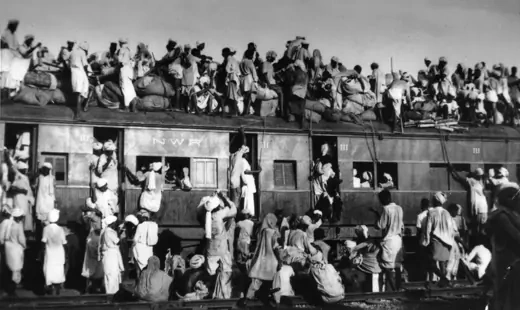
AP Photo
Britain declares the end of its colonial rule of the subcontinent and passes the Indian Independence Act [PDF], which divides the territory into Muslim-majority Pakistan and secular India, whose population is majority Hindu. Violent clashes between Hindus, Sikhs, and Muslims follow, and as many as a million die in bloodshed amidst the forced migration of up to twenty million people.
1949
October 13, 1949
Prime Minister Nehru Visits U.S.
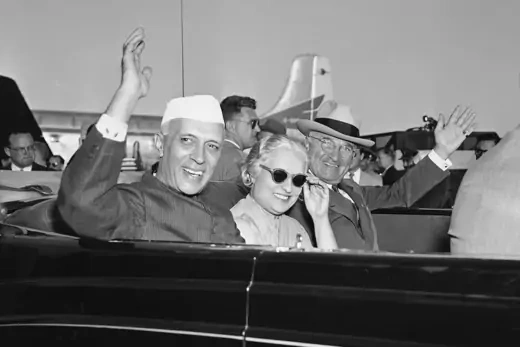
AP Photo
Prime Minister Pandit Jawaharlal Nehru meets with U.S. president Harry S. Truman on a multi-week tour tour of the United States. The trip precedes India’s formal proclamation of neutrality in the developing Cold War, in which it would take a leadership role within the Non-Alignment movement. This sets the tone for U.S.-India relations throughout the Cold War, creating constraints within the relationship, as well as opportunity for amity between Delhi and Moscow.
1959
February 10, 1959
Martin Luther King Jr. Studies Gandhian Nonviolence

Bettmann/Getty Images
Inspired by Mahatma Gandhi’s nonviolent struggle for national independence, U.S. civil rights leader Martin Luther King Jr. arrives in India for a month-long tour. He meets with Prime Minister Nehru, Gandhi’s family and friends, and scholars. After returning to the United States, King says the trip reaffirmed his commitment to nonviolent resistance, calling it “the most potent weapon available to oppressed people in their struggle for justice and human dignity.”
1959
December 9, 1959
President Eisenhower Visits India
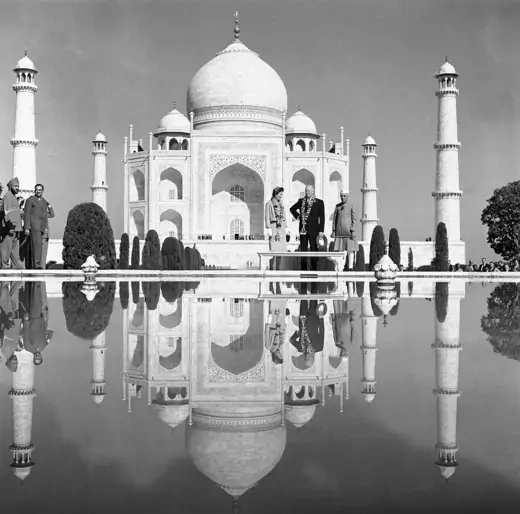
AP Photo
President Dwight Eisenhower is the first serving U.S. president to visit the country. Eisenhower meets with President Rajendra Prasad and Prime Minister Jawaharlal Nehru, and addresses Parliament.
1962
U.S. Universities Support Indian Technological Institute
Nine American universities and the U.S. Agency for International Development (USAID) help establish one of the first Indian Institutes of Technology. Under the Kanpur Indo-American Program [PDF], American faculty members develop academic programs and research laboratories at the new university over a decade. The partnership is one of many examples of higher education collaboration between the two countries.
1962
October 20, 1962
India, China Fight Border War
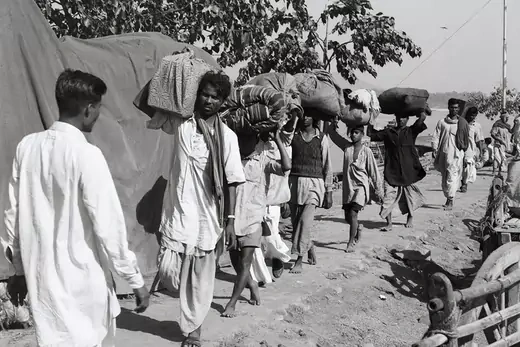
AP Photo
War breaks out between India and China over a disputed frontier. Prime Minister Jawaharlal Nehru writes to President John F. Kennedy to request support from the United States. Washington supports India in the conflict, recognizing the McMahon line as the border, and provides air assistance and arms. Until the 1965 India-Pakistan War, strategic and military ties between Washington and Delhi remain close.
1963
U.S. Agronomist Spurs Food Revolution
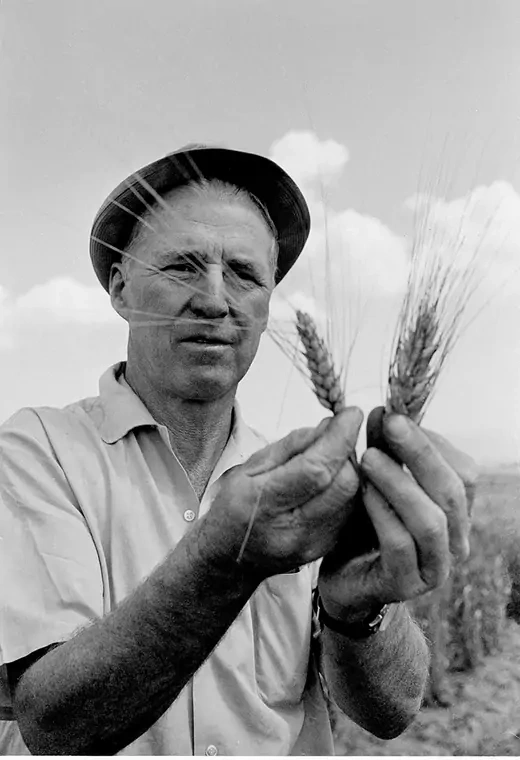
AP Photo
Norman Borlaug travels to India to begin testing high-yield wheat varieties. His collaboration with Indian scientist Dr. M.S. Swaminathan results in the “Green Revolution,” and India goes from food scarcity to self-sufficiency within a decade.
1971
India, Pakistan Go to War
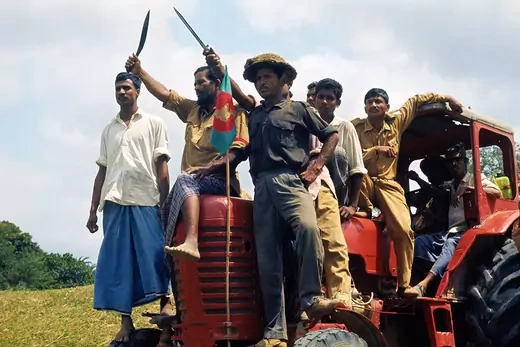
Bettmann/Getty Images
India and Pakistan become embroiled in their third conflict as Pakistan descends into a civil war that ends with the creation of Bangladesh, formerly East Pakistan, on December 6. Despite evidence of the Pakistan Army’s violence against its own citizens in East Pakistan, the United States sides with Islamabad, given its mediating role in Nixon’s rapprochement with China. India also signs a twenty-year Treaty of Friendship and Cooperation with the Soviet Union in August, sharply deviating from its previous position of non-alignment in the Cold War.
1974
May 18, 1974
India Completes First Nuclear Test
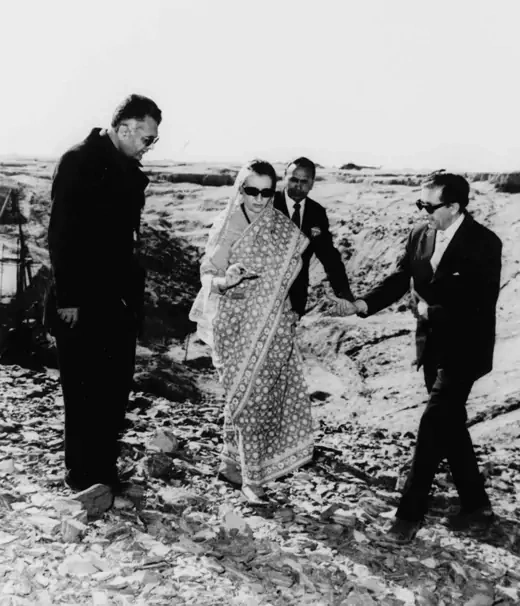
AP Photo
India detonates its first nuclear device, becoming the first nation outside the five permanent members of the United Nations Security Council to have declared nuclear capabilities. The move contributes to a period of estrangement between the United States and India that lasts over two decades.
1978
January 1, 1978
President Carter Visits India

Charles Harrity/AP Photo
U.S. President Jimmy Carter visits India on a three-day official trip to meet with Indian President Neelam Sanjiva Reddy and Prime Minister Morarji Desai, and address Parliament. Desai reciprocates with an official six-day visit to Washington in June.
1978
March 10, 1978
U.S. Enacts Nonproliferation Act
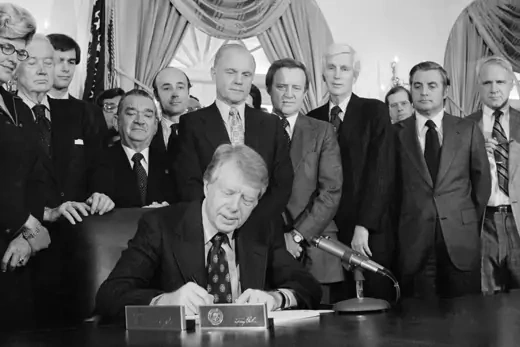
AP Photo
The Carter administration enacts the Nuclear Nonproliferation Act, which requires countries not included in the Nonproliferation Treaty—which includes India—to allow inspections of all nuclear facilities by the International Atomic Energy Agency. India refuses, and Washington ends all nuclear assistance to Delhi.
1982
July 28, 1982
Indira Gandhi Mends Ties During U.S. Visit
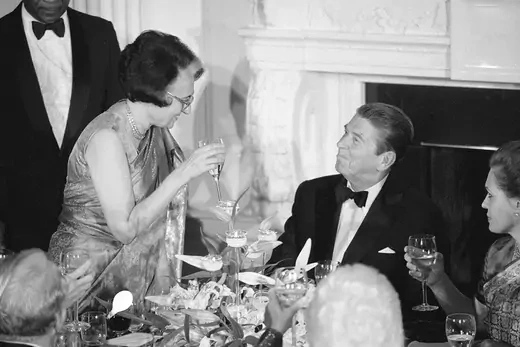
Bettmann/Getty Images
Prime Minister Indira Gandhi meets with President Ronald Reagan during a state visit to improve the countries’ strained relationship. Gandhi highlights differences between the United States and India in a speech at the White House, but says they should “find a common area, how so ever small.” The leaders end up agreeing to increase cooperation and resolve a dispute over nuclear power, four years after the United States blocked shipments of low-enriched uranium fuel needed for India’s Tarapur power plant. Two years later, Vice President George H.W. Bush leads a high-level visit to New Delhi.
1984
October 31, 1984
Indira Gandhi Assassinated
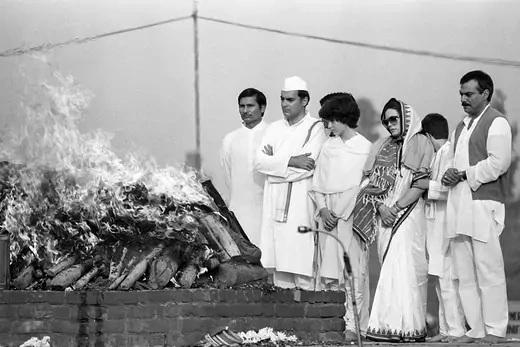
Bettmann/Getty Images
Prime Minister Gandhi is assassinated at her New Delhi residence by Sikh security guards seeking vengeance after her authorization of a military attack on a revered Sikh temple in Amritsar five months prior. Gandhi, the daughter of India’s first prime minister, Jawaharlal Nehru, first took office in 1966 and served three consecutive terms until 1977. She served a fourth term starting in 1980 and held office until her death. Gandhi is succeeded as prime minister by her son, Rajiv.
1984
December 3, 1984
Thousands Die in Bhopal Leak
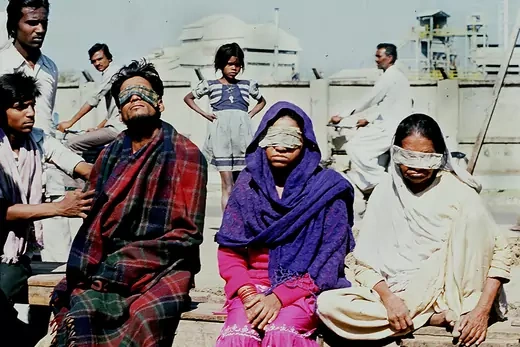
AFP/Getty Images
A toxic gas and chemical leak at American-owned Union Carbide Pesticide Plant in Bhopal, India, kills thousands. India unsuccessfully seeks extradition of the company’s chief executive from the United States for criminal prosecution as the death and disability toll climbs to the tens of thousands in the ensuing years. The incident harms U.S.-India relations, and continues to complicate the bilateral relationship years after.
1990
May 20, 1990
U.S. Crisis Mission Travels to Region

Kamal Kishore/Reuters
Deputy National Security Advisor Robert Gates travels to India and Pakistan to defuse tensions over the rapidly escalating insurgency in Kashmir. The trip comes amid fears of potential nuclear warfare between Pakistan and India.
1991
July 24, 1991
India Launches Economic Reforms
The government of Prime Minister P.V. Narasimha Rao launches sweeping economic reforms that help expand economic ties with the United States. Finance Minister Manmohan Singh oversees the opening of India’s economy to international trade and investment, deregulation, initiation of privatisation, tax reforms, and inflation controlling measures that catalyze decades of fast growth.
1998
May 11, 1998
India Tests Nuclear Devices
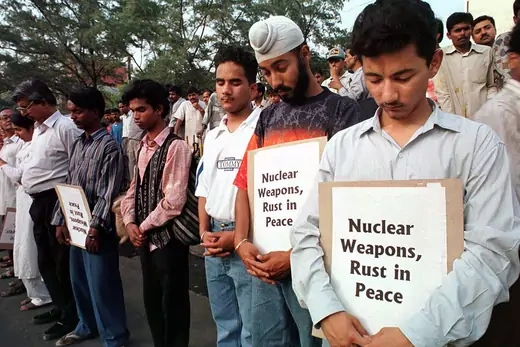
Reuters
The Indian government announces the completion of a series of underground nuclear tests close to the border with Pakistan, surprising U.S. intelligence organizations and raising fears the move could spark a regional nuclear arms race. The tests draw international condemnation and badly damage India’s relationship with the United States. After recalling the U.S. ambassador to India, President Bill Clinton imposes economic sanctions, required under U.S. law.
1999
March 3, 1999
Pakistan, India Clash in Kashmir
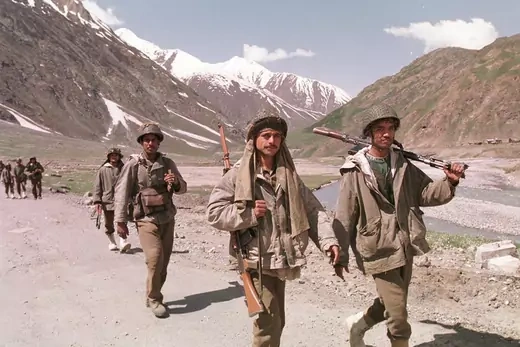
Vijay Gupta/Getty Images
Pakistani forces infiltrate Indian-administered Kashmir. India launches air strikes in return, and armed conflict continues through early July. After President Clinton summons Pakistani Prime Minister Nawaz Sharif to Washington for a Fourth of July emergency meeting, Sharif withdraws Pakistani forces from their positions beyond the Line of Control.
2000
March 20, 2000
Clinton Trip Signals Warming Ties
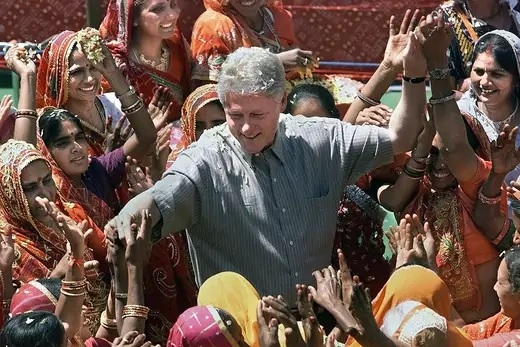
J. Scott Applewhite/Reuters
President Bill Clinton makes the first U.S. presidential trip to India since 1978. The visit ends the estrangement of the post-1998 Indian nuclear weapons tests, although the Clinton administration presses India’s government to sign the Comprehensive Test Ban Treaty. The Indo-U.S. Science and Technology Forum is also established during the visit. As India’s economy begins to take off, the trip indicates a further shift in Washington’s regional orientation away from its Cold War alliance with Pakistan.
2001
September 22, 2001
U.S. Lifts India Sanctions
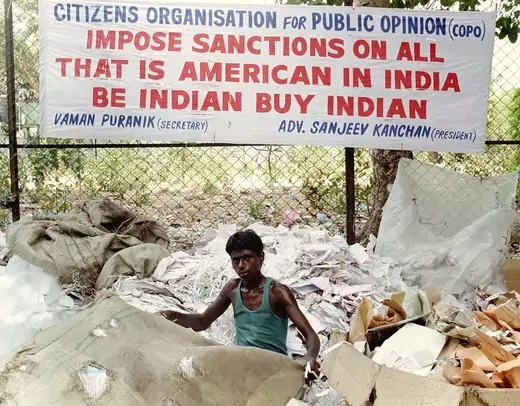
Savita Kirloskar/Reuters
President George W. Bush’s administration lifts all remaining U.S. sanctions that were imposed on India after its 1998 nuclear test. Most economic sanctions had been eased within a few months of their imposition, and Congress authorized the president to remove all remaining restrictions in 1999.
2005
March 15, 2005
Energy Security Dialogue Begins
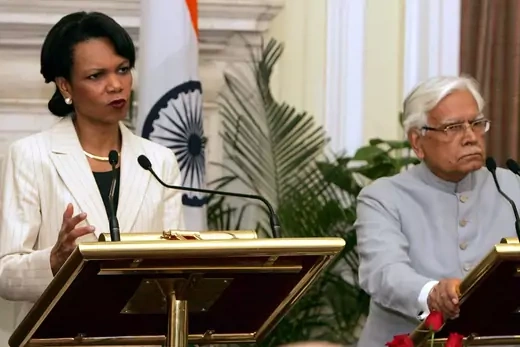
Kamal Kishore/Reuters
U.S. Secretary of State Condoleezza Rice visits New Delhi, where she and Indian officials agree to start a dialogue on energy security. The visit underscores an upswing in relations despite tensions over India’s possible energy cooperation with Iran and the U.S. sale of fighter jets to Pakistan.
2005
June 28, 2005
U.S., India Sign New Defense Framework
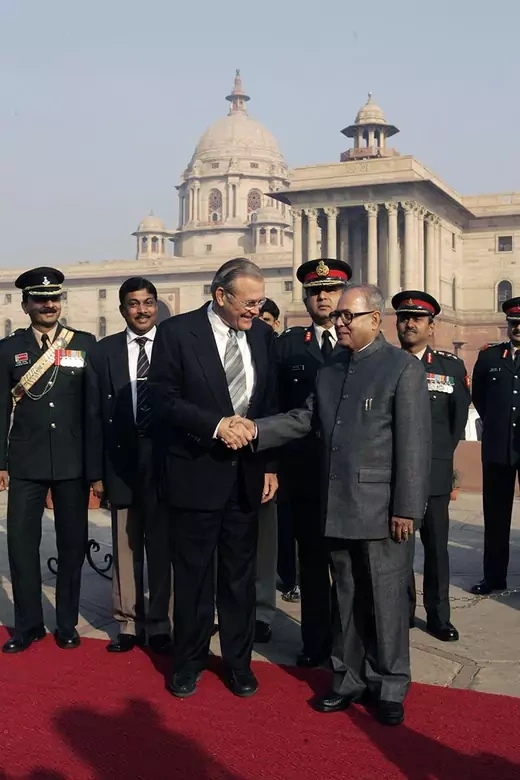
Larry Downing/Reuters
The United States and India sign the New Framework for the U.S.-India Defense Relationship [PDF], which sets priorities for defense cooperation in maritime security, humanitarian assistance/disaster relief, and counterterrorism. In October, the two countries conduct the largest naval exercise to date, followed by major air and land exercises.
2005
July 18, 2005
Landmark Civil Nuclear Deal Drafted
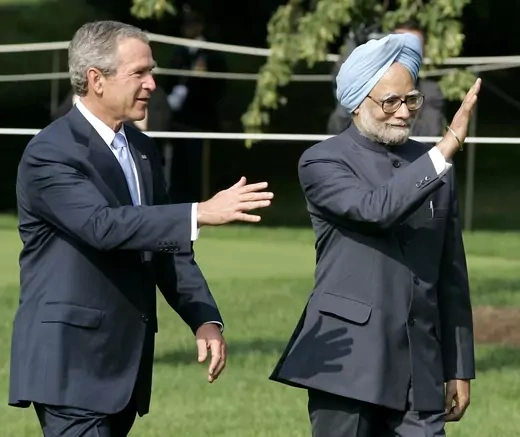
Larry Downing/Reuters
India and the United States ink the Civil Nuclear Cooperation Initiative, a framework that lifts a three-decade U.S. moratorium on nuclear energy trade with India. Under the agreement, India agrees to separate its civil and military nuclear facilities and place all its civil resources under International Atomic Energy Agency (IAEA) safeguards. In exchange, the United States agrees to work toward full civil nuclear cooperation with India. Congress gives final approval in October 2008.
2006
March 1, 2006
President Bush Visits India
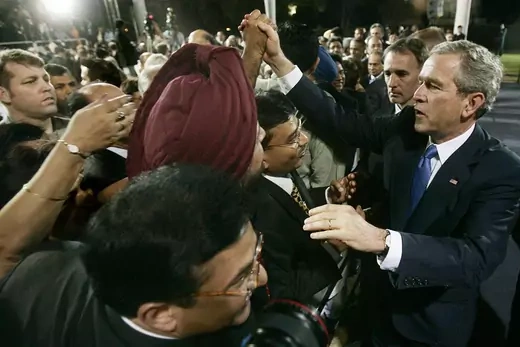
Jim Young/Reuters
President Bush makes a visit to India, where he and Indian Prime Minister Manmohan Singh finalize the framework of the civil nuclear deal and boost security and economic ties. The nuclear deal, completed in July 2007, makes India the only country outside of the Nonproliferation Treaty that has nuclear capabilities and is allowed to participate in nuclear commerce.
2007
April 27, 2007
Mangoes-for-Motorcycles Deal Signals Deepening Trade Ties
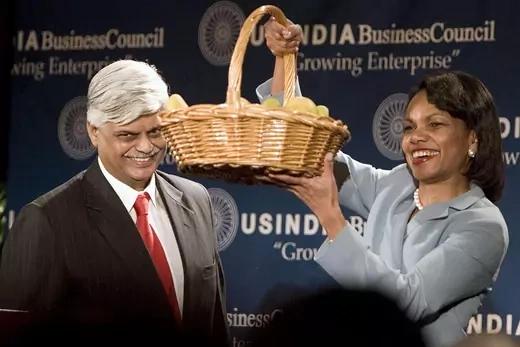
Joshua Roberts/Reuters
Some of the first shipments of Indian mangoes arrive in the United States, ending an eighteen-year ban on importing the fruit. The ban is lifted as part of an agreement reached by President Bush and Prime Minister Singh in 2006 to double trade between the countries within three years. In response, India says it will relax restrictions on importing Harley-Davidson motorcycles from the United States. Bilateral trade in goods and services totaled around $45 billion in 2006 and rose to more than $70 billion in 2010, according to the U.S. Bureau of Economic Analysis.
2008
September 6, 2008
Nuclear Energy Regulator Allows Indian Nuclear Trade
The Nuclear Suppliers Group (NSG), an intergovernmental body that sets guidelines for nuclear exports, allows an exemption to its rules [PDF] that permits India to engage in nuclear trade for the first time in three decades. The waiver is approved following intense diplomatic efforts by the Bush administration, dating back to 2005 when Washington and New Delhi signed the Civil Nuclear Cooperation Initiative. Ahead of the NSG negotiations, Secretary Rice lobbies foreign counterparts to support the waiver, making more than two dozen phone calls. Analysts say the deal is critical to India’s economic growth and satisfying increasing energy demands.
2008
November 8, 2008
Indian Spacecraft Makes First Moon Landing
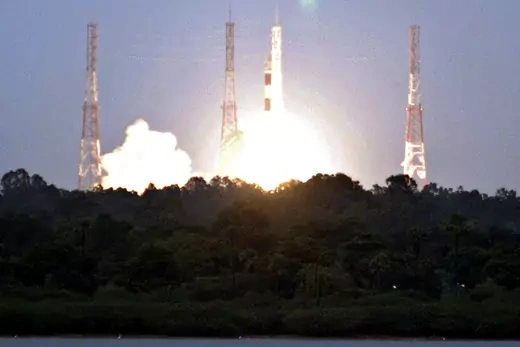
Babu/Reuters
Chandrayaan-1 becomes the first Indian spacecraft to land on the moon. It carries two scientific instruments designed by NASA scientists, which later discover water molecules on the moon’s surface. The achievement is one of many resulting from ongoing U.S.-India space cooperation dating back to 1963.
2008
November 26, 2008
Terrorists Attack Taj Mahal Palace Hotel
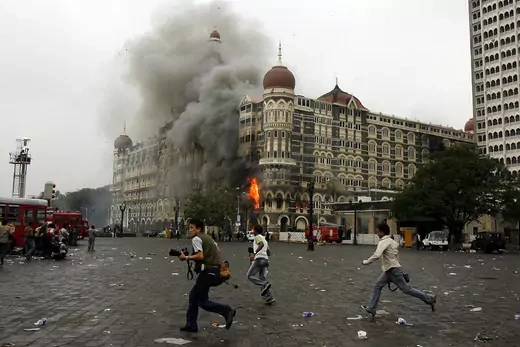
Punit Paranjpe/Reuters
Lashkar-e-Taiba terrorists from Pakistan attack the Taj Mahal Palace Hotel in Mumbai. More than three hundred citizens die in the three-day conflagration, including six Americans. The United States cooperates closely with Indian authorities, sending FBI investigators and forensics experts.
2009
November 24, 2009
Prime Minister Singh Begins U.S. State Visit
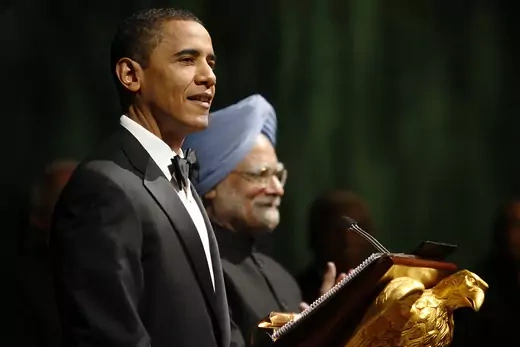
Jason Reed/Reuters
U.S. President Barack Obama hosts the inaugural state visit of Indian Prime Minister Manmohan Singh. Despite its symbolic importance, the trip fails to yield any significant breakthroughs in the bilateral relationship.
2010
April 5, 2010
U.S. Treasury Secretary Launches Economic Partnership
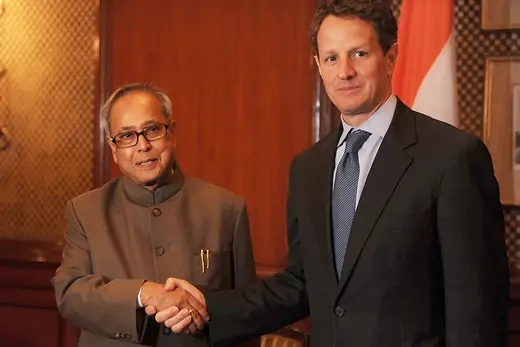
Raveendran/AFP/Getty Images
U.S. Treasury Secretary Timothy Geithner makes his first official trip to India to launch the new U.S.-India Economic and Financial Partnership with Indian Finance Minister Pranab Mukherjee. The ministerial-level meetings kick off an effort to institutionalize deeper bilateral relations on economic and financial sector issues.
2010
June 1, 2010
U.S., India Hold First Strategic Dialogue
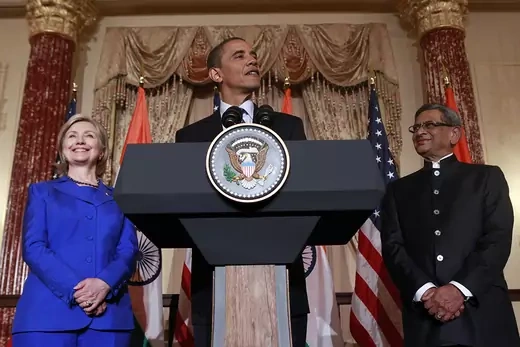
Kevin Lamarque/Reuters
The United States and India formally convene the first U.S.-India Strategic Dialogue. A large, high-ranking delegation of Indian officials visits Washington, DC, and Secretary Clinton lauds India as “an indispensable partner.” President Obama says the relationship “will be a defining partnership in the twenty-first century.” Subsequent dialogues follow annually.
2010
November 5, 2010
Obama Backs India Bid for UN Security Council
President Obama visits India, where he addresses Parliament and backs the country’s long-held bid for a permanent seat on the United Nations Security Council. The trip also highlights the countries’ economic ties, with Obama announcing $14.9 billion in trade deals. However, trade concerns around access to Indian markets and issues surrounding civil nuclear cooperation cloud the talks.
2011
July 19, 2011
U.S., India Ink Cybersecurity Memorandum
The United States and India sign a Memorandum of Understanding in New Delhi to promote closer cybersecurity cooperation. The agreement is designed to fulfill one of the pillars of the U.S.-India Strategic Dialogue.
2012
May 30, 2012
Panetta Boosts Military Ties

Jim Watson/Reuters
Secretary of Defense Leon Panetta visits India to bolster military ties in the wake of the Obama administration’s announced “pivot” to Asia. The trip marks the first such visit since former Secretary of Defense Robert Gates met with Indian counterparts in January 2010.
2013
September 27, 2013
Singh Makes Last Visit to Washington
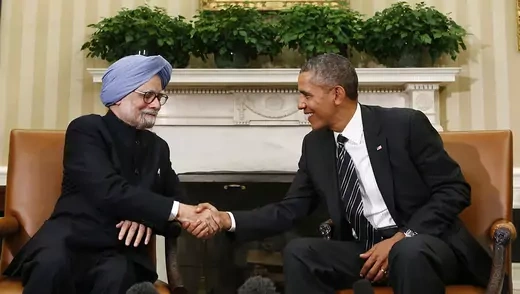
Kevin Lamarque/Reuters
Manmohan Singh visits Washington in his last visit to the United States as India’s prime minister. The trip, which focuses on security, trade, immigration reform, and the civilian nuclear deal, marks the third meeting between Singh and Obama in four years. It comes amid a backdrop of domestic political issues in Delhi, a troubled Indian economy, and a government shutdown crippling Washington.
2014
March 31, 2014
Diplomatic Row Sours Ties
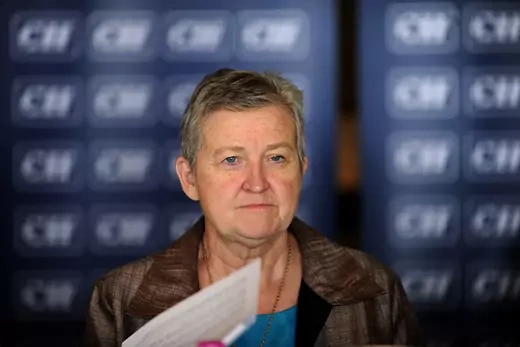
Sajjad Hussain/AFP/GettyImages
The U.S. embassy in India announces Ambassador Nancy Powell’s resignation in the wake of a dispute over the arrest of an Indian diplomat in New York. The announcement comes amid the run-up to high-profile national elections.
2014
May 20, 2014
Obama Invites Modi to U.S.
The Hindu nationalist BJP party wins national elections in a landslide, elevating Narendra Modi to prime minister. President Obama congratulates Modi and invites him to the White House, reversing an earlier visa ban. Modi had been barred from entering the country over U.S. concerns about the 2002 massacre of Muslims in the state of Gujarat, which occurred when Modi was the state’s chief minister.
2014
September 26, 2014
Modi Makes High-Profile U.S. Visit
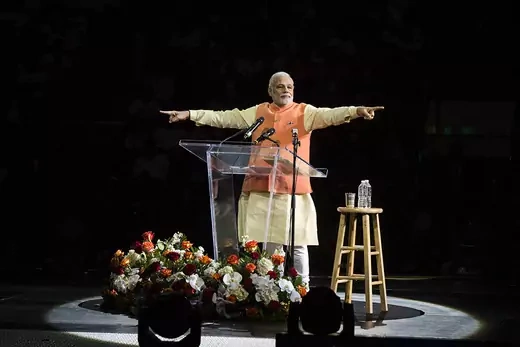
Lucas Jackson/Reuters
Modi makes his first visit as prime minister to the United States, aiming to attract investment and firm up the U.S.-India strategic partnership. Modi’s events include a sold-out speech in New York’s Madison Square Garden and meetings with U.S. business executives. In Washington, Modi and President Obama reach agreement on a memorandum of understanding between the Export-Import Bank and an Indian energy agency, which provides up to $1 billion to help India develop low-carbon energy alternatives and aid U.S. renewable energy exports to India.
2015
January 24, 2015
Obama’s Second India Visit Elevates Ties
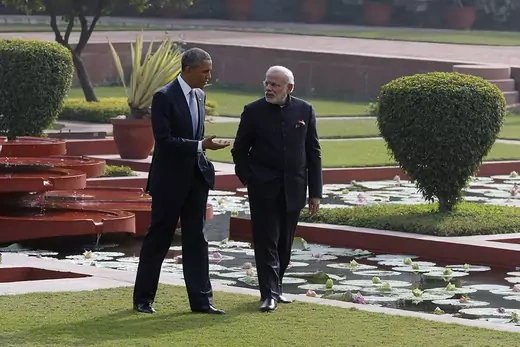
Jim Bourg/Reuters
President Obama makes his second visit to India as head of state for India’s Republic Day celebrations. The president heralds the relationship between the world’s two largest democracies, saying, “America can be India’s best partner.” Obama and Prime Minister Modi announce a breakthrough on nuclear-related issues that could help implement the U.S.-India civil nuclear deal. Six months later, U.S. Secretary of Defense Ashton Carter and India’s defense minister, Manohar Parrikar, sign documents to renew the ten-year U.S.-India Defense Framework Agreement.
2016
June 7, 2016
Obama Recognizes India as Major Defense Partner
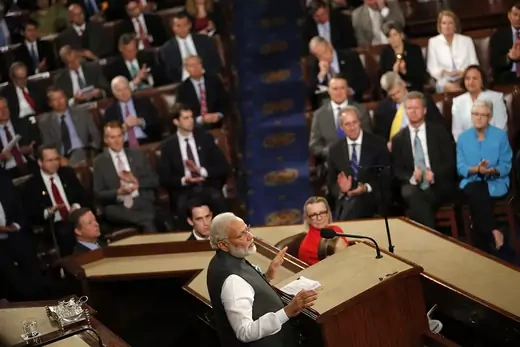
Carlos Barria/Reuters
During Prime Minister Modi and President Obama’s final meeting in the White House, the United States elevates India to a major defense partner, a status no other country holds. An expansion of the ten-year defense agreement renewed in 2015, the designation, which became law in August 2018, means that India will enjoy some of the benefits of being a U.S. treaty ally, such as access to defense technology, though the alliance is not a formal one. In a speech before Congress a day later, Modi celebrates his country’s growing diplomatic and economic ties with the United States. Two months later, the United States and India sign an agreement on deeper military cooperation after nearly a decade of negotiations.
2017
February 22, 2017
Indian Engineers Attacked in Hate Crime
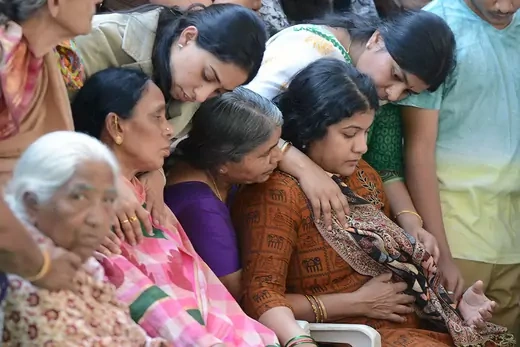
Noah Seelam/AFP/Getty Images
After confronting two Indian men at a restaurant in Kansas, yelling “get out of my country,” a white man shoots the two men, as well as a third who intervened. One of the men, Srinivas Kuchibhotla, dies, and his friend, Alok Madasani, and the bystander are injured. India sends nearly one-fifth of the foreign students studying in the United States and more than three-quarters of the highly skilled workers approved for H-1B visas [PDF], but the racist attack sparks concern among Indians that the United States is not safe for them. Increasing anti-immigrant rhetoric causes some prospective applicants to rethink their plans.
2017
June 26, 2017
Trump, Modi Meet for First Time
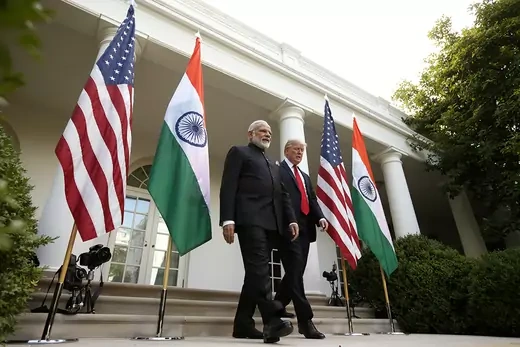
Kevin Lamarque/Reuters
President Donald J. Trump welcomes Prime Minister Modi to the White House for their first face-to-face meeting. Though Trump had raised sharp disagreements with India over trade, climate change, and H-1B visas, these issues are sidelined during the leaders’ summit, and their joint statement emphasizes strengthening their defense partnership, cooperating on counterterrorism efforts, and boosting economic ties.
2018
September 6, 2018
Another Step Forward Taken in Defense Partnership
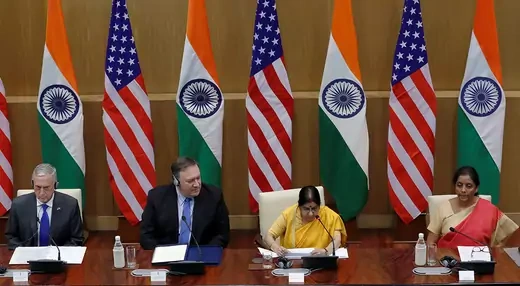
Adnan Abidi/Reuters
During a “two-plus-two” dialogue in New Delhi, U.S. Secretary of State Mike Pompeo and Secretary of Defense Jim Mattis sign an agreement with Indian Minister of External Affairs Sushma Swaraj and Defense Minister Nirmala Sitharaman. The Communications Compatibility and Security Agreement (COMCASA) gives India access to advanced communication technology used in U.S. defense equipment and allows real-time information sharing between the two countries’ militaries. The agreement had been under negotiation for nearly a decade.
2019
June 5, 2019
Trump Ends India’s Special Trade Status
The Trump administration terminates India’s preferential trade status, part of a program dating back to the 1970s that allows products from developing countries to enter the U.S. market duty free. Trump says India has not provided “equitable and reasonable access” to its own market. Weeks later, India slaps tariffs on twenty-eight U.S. products in response to U.S. duties on steel and aluminum imposed in 2018. New Delhi had drafted the retaliatory tariffs earlier but held off on implementing them amid trade talks.
2020
February 24, 2020
Trump Makes First Visit to India
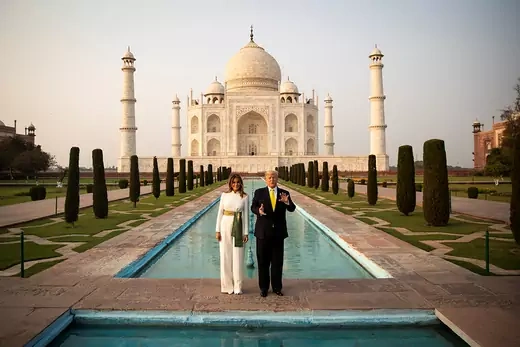
Al Drago/Reuters
At an Ahmedabad rally with an audience of more than one hundred thousand people, President Trump praises the U.S.-India relationship and Prime Minister Modi’s leadership. The two leaders announce plans to work together on counternarcotics and mental health. India agrees to purchase $3 billion in U.S. military equipment, and U.S.-based oil company ExxonMobil announces a deal with state-owned Indian Oil Corporation. Despite years of negotiations aimed at resolving trade issues, officials do not reach an agreement, with divisions remaining over agricultural products, tariffs, and other areas. Amid Trump’s visit, deadly clashes between Hindus and Muslims that are connected to a controversial citizenship law break out in New Delhi. Trump does not publicly mention the violence or take a firm stance on the law, which critics say discriminates against Muslims.
2020
October 27, 2020
Officials Sign Deal to Boost Intelligence Sharing
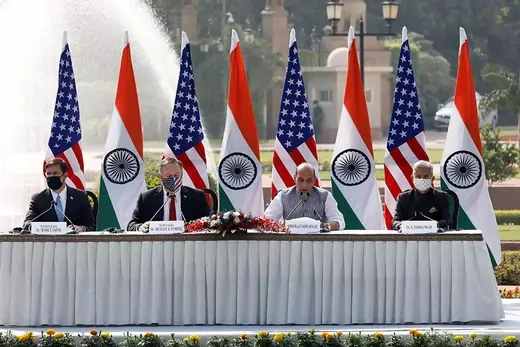
Adnan Abidi/Reuters
The top U.S. and Indian defense and foreign affairs officials sign an intelligence-sharing agreement during the third round of their two-plus-two dialogue. The Basic Exchange and Cooperation Agreement (BECA) is the last of four foundational military agreements signed by both countries over the past two decades. It allows for the sharing of sensitive geospatial data to boost the accuracy of Indian drones and cruise missiles. During a press conference, U.S. Secretary of Defense Mark T. Esper emphasizes the countries’ commitment to keeping the Indo-Pacific free and open, “particularly in light of increasing aggression and destabilizing activities by China.”
2021
September 24, 2021
First In-Person Quad Leaders’ Summit
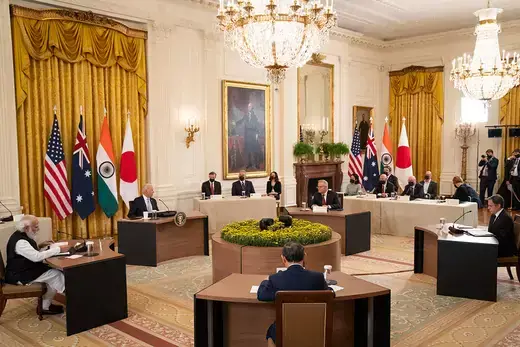
Sarahbeth Maney-Pool/Getty Images
President Joe Biden hosts Prime Minister Modi at the White House alongside the prime ministers of Australia and Japan for the first in-person leaders’ summit of the informal security dialogue known as the Quad. The leaders agreed to coordinate their strategic goals, including by donating more than one billion COVID-19 vaccines globally and forming a low-carbon shipping network. A year earlier, the group convened their largest joint military exercise in a decade amid heightened regional tensions with China.
2023
January 31, 2023
Deepening Defense and Economic Cooperation
U.S. and Indian officials announce the Initiative on Critical and Emerging Technologies (iCET), which aims to expand bilateral technology and defense cooperation, including provisions on weapons, artificial intelligence, and semiconductors. The countries follow this initiative with an announcement of a strategic trade dialogue that focuses on facilitating the development of trade and critical technologies while assuring appropriate security measures. As part of the iCET, U.S. officials seek to reduce India’s purchase of Russian arms, which they say helps finance Russia’s war in Ukraine. Russia remains the largest supplier of Indian matériel in mid-2023, but sales slow as India seeks to avoid violating U.S. sanctions.
2023
June 20, 2023
Modi Makes First State Visit to Washington
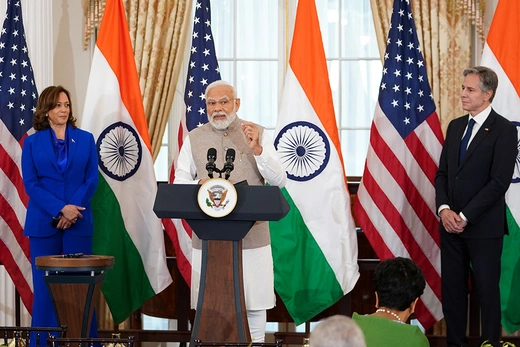
Kevin Lamarque/Reuters
Modi’s official state visit to Washington—the highest U.S. diplomatic protocol for visiting leaders—marks a further deepening of the bilateral relationship. While Modi previously visited Washington as prime minister, this year’s state visit is the third of its kind from an Indian leader to the United States since 1963. The countries make strides in their defense and strategic partnership, and the United States commits to increasing investments in India’s semiconductor chip industries to upward of $825 million, while an Indian venture company pledges to invest up to $1.5 billion in the U.S. solar energy supply.
2023
September 9, 2023
Bilateral Ties Deepen at G20 Leaders’ Summit
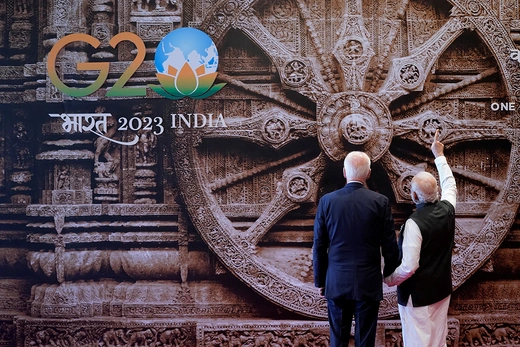
Evan Vucci/Reuters
President Biden visits Modi in New Delhi ahead of the 2023 Group of Twenty (G20) Leaders’ Summit, hosted by India. The two also cohost a meeting [PDF] with G20 leaders to discuss increasing investments in high-quality infrastructure and development projects through the India-Middle East-Europe Economic Connectivity Corridor (IMEC)—which analysts say is meant to serve as a Western counter to China’s Belt and Road Initiative—and the Partnership for Global Infrastructure and Investment. In a joint statement, Biden also backs a reformed UN Security Council with India as a permanent member. The announcement builds on the Biden administration’s previous endorsement of India, alongside Germany and Japan, as a permanent Security Council member.
2024
September 21 – 24, 2024
Biden, Modi Announce Semiconductor Partnership
Ahead of the Quad Summit in Biden’s home state of Delaware, the two leaders announce a series of initiatives, including greater cooperation in cyberspace, cybersecurity, defense, and global health. They also launch the U.S.-India Roadmap to Build Safe and Secure Global Clean Energy Supply Chains, an initiative geared toward expanding bilateral technical, financial, and policy support for U.S. and Indian manufacturing of clean energy technology. The initiative seeks to unlock $1 billion in multilateral financing for the clean energy industry with a focus on Africa, where China has made significant investments in renewable energy.
2025
February 12, 2025
Trump and Modi Discuss Security, Trade in Washington
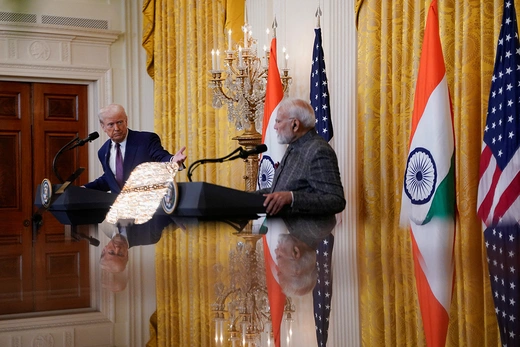
Nathan Howard/Reuters
Modi—who had cordial relations with Trump during his first administration—meets with Trump early in his second term to discuss defense, trade, and technological innovation, among other high-priority issues. The two leaders launch a new initiative, the U.S.-India Catalyzing Opportunities for Military Partnership, Accelerated Commerce & Technology (COMPACT) for the Twenty-First Century. The plan aims to bolster defense cooperation and manufacturing; strengthen bilateral innovation in artificial intelligence and science and technology; and commits to increasing oil, gas, and nuclear energy trade, including plans to develop U.S.-designed nuclear modular reactors in India. With the implementation of Trump’s reciprocal trade agenda, he and Modi also discuss reducing the U.S. trade deficit with India, which is nearly $46 billion, and decreasing India’s import tax on U.S. goods.
2025
August 2025
U.S. Tariffs Jolt Bilateral Relations
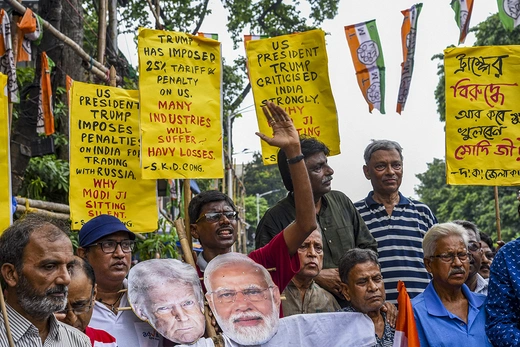
Debajyoti Chakraborty/Middle East Images/AFP/Getty Images
After a ninety-day pause on Trump’s sweeping April 2 “Liberation Day” tariffs, Washington announces a 25 percent tariff on New Delhi. The Trump administration later doubles the tariff to 50 percent in an effort to penalize India for its continued purchasing of Russian oil. Indian Foreign Minister S. Jaishankar pushes back on the new rate, calling it “unfair, unjustified, and unreasonable.” The levies, which are the highest of any U.S. trading partner, come after five rounds of bilateral negotiations that fail to produce an official trade deal. Modi responds harshly, stating that “India will never compromise” and that the country is “ready to pay a heavy price.” Some experts argue that Trump’s move marks one of the lowest points in U.S.-India relations in almost twenty-five years.